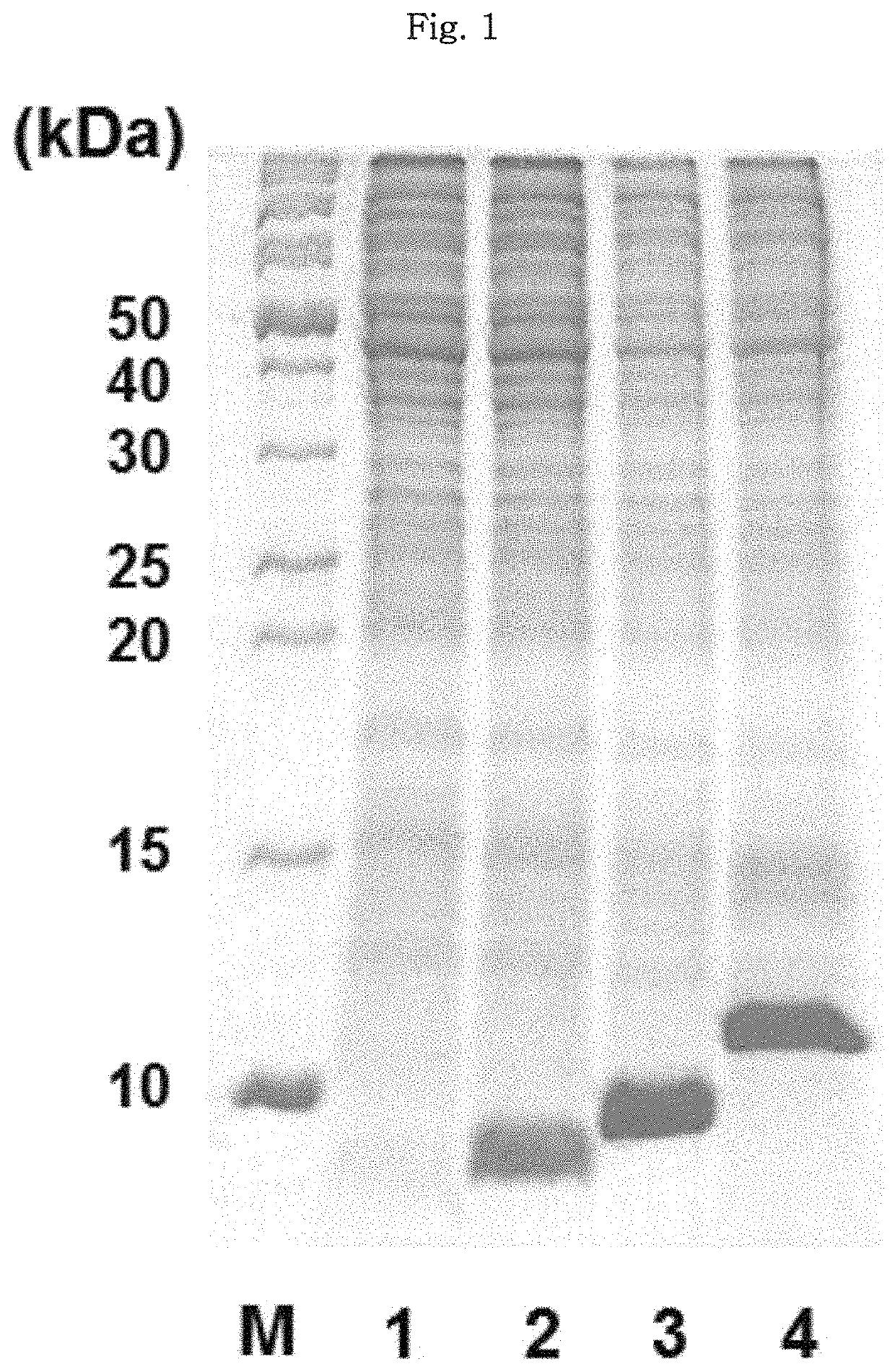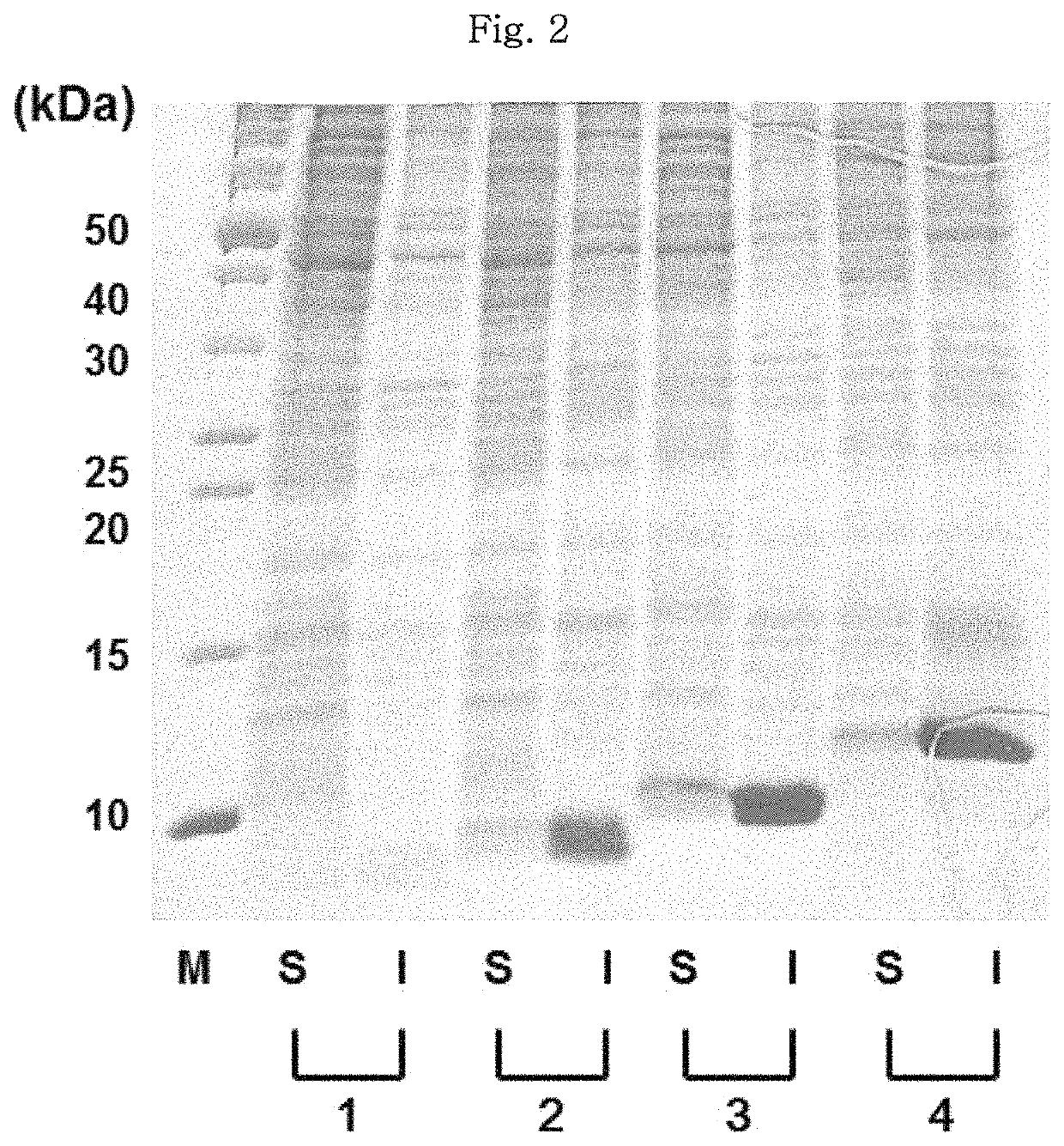N-terminal fusion partner for producing recombinant polypeptide, and method for producing recombinant polypeptide using same
a fusion partner and n-terminal technology, applied in the field of n-terminal fusion partners, can solve problems such as yield reduction, and achieve the effects of improving the yield of a target polypeptide, low molecular weight, and easy degradability of the amino terminus
- Summary
- Abstract
- Description
- Claims
- Application Information
AI Technical Summary
Benefits of technology
Problems solved by technology
Method used
Image
Examples
example 1
on and Production of hPTH 1-34 Fusion Polypeptide
example 1-1
of hPTH 1-34 Fusion Polypeptide Expression Plasmid
[0176]A gene for hPTH 1-34 fusion polypeptide was synthesized in the overlap extension polymerase chain reaction (OE-PCR) system. In this regard, the hPTH 1-34 fusion polypeptide included any one of PG07 (SEQ ID NO:9), PG15 (SEQ ID NO:31) and PG43 (SEQ ID NO:119) as an amino-terminal fusion partner, a 6-histidine tag (SEQ ID NO:140), a TEV protease recognition sequence (SEQ ID NO:146), and an hPTH 1-34 amino acid sequence (SEQ ID NO:151).
[0177]As a control, hPTH 1-34 fusion polypeptide (H6TEV-hPTH1-34) included a 6-histidine tag (SEQ ID NO:140), a TEV protease recognition sequence (SEQ ID NO:146) and an hPTH 1-34 amino acid sequence (SEQ ID NO:151), but not any amino-terminal fusion partner. The gene of each fusion polypeptide included recognition sequences for restriction enzymes such as Ndel, Ncol and Xhol, and one termination codon. The nucleotide sequences encoding the hPTH 1-34 fusion polypeptides corresponded to the sequence id...
example 1-2
of Transformed Cell and Expression of hPTH 1-34
[0181]The E. coli cell stock containing the transformed expression plasmids of hPTH 1-34 fusion polypeptide as maintained at −80° C. was thawed at the room temperature. 50 pl of the thawed cell stock was added to a test tube loaded with 5 ml of an LB liquid medium containing kanamycin at 50 μg / ml. The cultivation of the starter culture was carried out for 12 hours in a shaking incubator at 37° C. After cultivation of the starter culture, 2 ml of the E. coli cell stock was added to a flask loaded with 200 ml of an LB liquid medium containing kanamycin at 50 μg / ml, and the E. coli cells were cultivated in a shaking incubator at 37° C. Once the cells reached an optical density (OD600) of about 1.0 after about 3 hours of incubation, IPTG was added to a final concentration of 0.1 mM to induce the expression of hPTH 1-34 fusion polypeptide. After 4 hours of induction of expression, the optical density of the cells was measured.
PUM
| Property | Measurement | Unit |
|---|---|---|
| molecular weight | aaaaa | aaaaa |
| molecular weight | aaaaa | aaaaa |
| molecular weight | aaaaa | aaaaa |
Abstract
Description
Claims
Application Information
 Login to View More
Login to View More - R&D
- Intellectual Property
- Life Sciences
- Materials
- Tech Scout
- Unparalleled Data Quality
- Higher Quality Content
- 60% Fewer Hallucinations
Browse by: Latest US Patents, China's latest patents, Technical Efficacy Thesaurus, Application Domain, Technology Topic, Popular Technical Reports.
© 2025 PatSnap. All rights reserved.Legal|Privacy policy|Modern Slavery Act Transparency Statement|Sitemap|About US| Contact US: help@patsnap.com



